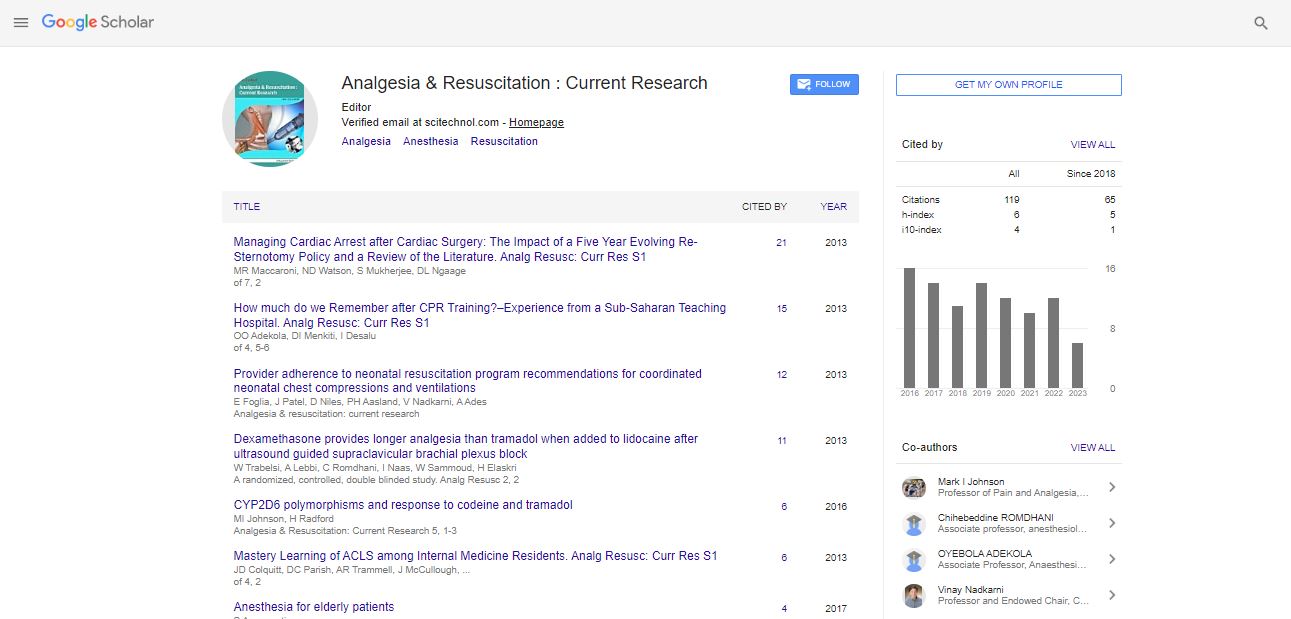The effectiveness of ketamine therapy (sub-anaesthetic infusion and lozenges) in the management of chronic non-cancer pain
Arun Aggarwal, Olly Zekry and Stephen Gibson
Royal Prince Alfred Hospital, Australia
: Analg Resusc: Curr Res
Abstract
Background: Ketamine is a non-competitive antagonist of N-Methyl-D- Aspertate (NMDA) receptors. It reduces NMDAmediated nociceptive responses in dorsal horn neurons by binding to the phencyclidine (PCP) site of the NMDA receptor-gated ion channel. Chronic noxious input to the dorsal horn cells (mediated mainly by C-fibres) results in the removal of magnesium from the NDMA receptors and their activation by glutamate. This causes prolonged depolarization spinal neurons, which leads to central desensitization that may result in hyperalgesia (an excessive response to a painful stimulus and allodynia (a painful response to a normally non-painful stimulus). Ketamine helps to minimize excessively painful responses. Studies have also proven that antagonizing these receptors improves opioid receptors sensitivity, reduces opioid tolerance and suppresses opioid-induced hyperalgesia. Currently, there is no evidence on the long-term effectiveness of ketamine infusions in the setting of chronic pain. Methodology: We performed a prospective study on 100 patients in the RPAH Pain Management Centre, to evaluate the long-term effect of a 3-7 day sub-anaesthetic ketamine infusion with refractory chronic, non-cancer between 2007 and 2012. A proportion of patients who responded to the infusion were commenced on lozenges to see if the improvement could be maintained. The assessment was based on the evaluation of a standardized questionnaire performed over a telephone conversation.We sought to determine whether ketamine provides long-term benefit to: • Reduce pain levels • Reduce opioid requirements Results: Our study showed that there was a significant reduction in pain intensity measured by VAS reducing from a mean of 6.38 before ketamine to 4.60 after ketamine infusion (p<0.005). There was also a significant reduction in opioid use from a mean morphine equivalent dose of 216 mg/day before ketamine to 89 mg/day after ketamine infusion (p<0.005). Current preliminary data suggests that around 35% of patients are able to maintain these opioid dose reductions with similar or reduced VAS scores, when placed on ketamine lozenges. This study answers several unresolved issues regarding the ketamine infusion. The most clinically important is whether it will be possible to maintain the ketamine induced pain relief for long-term, what is the percentage of relapse and what is the response to ketamine lozenges after a ketamine inpatient infusion. Conclusion: The preliminary results of this prospective study suggest that a sub-anesthetic inpatient infusion of ketamine may offer a promising therapeutic option for long-term relief of chronic refractory non-cancer pain. The study also establishes the safety and efficacy of this novel approach and strongly supports ketamine being a useful and safe long-term analgesic option.
Biography
Arun Aggarwal, MBBS, FRACP, FAFRM (RACP), FAFPM (ANZCA), received his PhD in 2004 from the University of Sydney. He is currently working as a Visiting Neurologist at Concord Hospital, a Chronic Pain Specialist at the RPAH Pain Clinic and a Rehabilitation Specialist at Balmain Hospital. He is a member of the Royal Australasian College of Physicians, Australasian Faculty of Rehabilitation Medicine and the Australasian Faculty of Pain Medicine. His research has included Electrophysiological Studies in Familial Amyotrophic Lateral Sclerosis with his primary paper, “Detection of pre-clinical motor neurone loss in SOD1 mutation carriers using motor unit number estimation” being widely cited in the international literature. He was awarded the Australian Association of Neurologists Young Investigator Award for his presentation of this paper in 1999 and was nominated for the Delsys Prize in 2012. He has written 3 book chapters on this subject and has also published widely on a number of different topics. He currently has a number of research projects in the areas of Chronic Pain and Parkinson’s disease. He is on the Editorial Board of the Journal of Clinical Trials. He is the current Chairman of Australian & NZ Association of Neurologists Neuro-Rehabilitation SubCommittee and on the Medical Advisory Board of Trigeminal Neuralgia Association (Australia).
 Spanish
Spanish  Chinese
Chinese  Russian
Russian  German
German  French
French  Japanese
Japanese  Portuguese
Portuguese  Hindi
Hindi 
